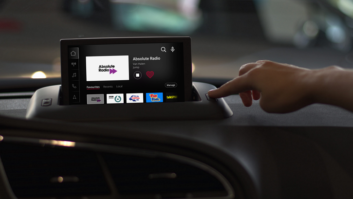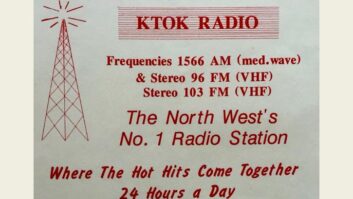This story appeared in the Radio World ebook “Spectacular Radio Studios.”
The Athletic Department at the University of Nebraska became the first major U.S. college athletic department to bring its multimedia operation fully in house, starting with the 2021–22 sports season. Part of the challenge was to bring up a statewide radio network on a very short timeline.
Director of Broadcast Operations Mike Elliott said the new facilities serve the Huskers Radio Network, with its 50+ radio stations across the Midwest, plus internet audio broadcasts across the world on Huskers.com and the official Husker App.
“This was not your typical radio station operation with ‘studios,’” Elliott said.
“The Huskers Radio Network had to be built to support up to four simultaneous live Husker sporting event broadcasts to terrestrial radio affiliates, with up to eight live simultaneous internet radio streams of live Husker sporting events and programming.”
The network has the capability to send a live video stream of the network’s “Sports Nightly” talk show, heard on more than two dozen terrestrial radio affiliates, plus internet radio streams and free live video streams on YouTube, Huskers.com and the app. The show produces audio and video two hours a day, five nights a week, 52 weeks a year.
The Broadcast Operations Center has five live event production pods. Video can be ingested from any Husker Athletics venue, and audio from anywhere across the globe.
“Private video capability with ultra low latency — under half a second — is part of the Broadcast Center to accommodate non-traveling, COVID-safe broadcasting of any home or road game, with talent in isolated studios and/or offsite locations around the country,” Elliott said. “All audio connectivity to remote sites was using Tieline technology and products.”

Bilingual broadcasts of all Husker Football games was a requirement of the facility, utilizing announcers at remote sites, often different remote sites for every game.
Elliott designed and built the Broadcast Operations Center and all REMI systems, with support from various Husker Athletics departments.
“When Nebraska Athletics made the decision to bring their radio operation in house, they asked me to join the Athletic Department as Director of Broadcast Operations,” he said. “Initially that was system design, RFPs, buildout, testing, and training of all staff to operate and produce Husker broadcasts.”
[Visit Radio World’s News and Business Page]
Elliott said the department took an unusual approach to producing road game radio broadcasts.
“Instead of sending producers and engineers to remote sites, we designed a radio version of the TV remote integration, or REMI, model. We send on-air talent to road games but do not send production or engineering staff. Using Tieline Gateway and Via codecs and their Cloud Codec Controller technology, a simple road kit travels. Each and every road game announcer microphone is individually returned to our Broadcast Operations Center. Each and every road talent has their own individual IFB mix to the broadcast operations center production team.
“Every remote game-site talent — play by play, color, stats, even the sideline reporter — appear on individual ‘pots’ on the Husker Broadcast Center pod assigned to that game,” he continued.

“With Wheatstone LXE and AoIP technology, we can easily generate custom mixes, and adjust any needed audio processing for each and every road game microphone while mixing at the Huskers Broadcast Center.”
For example, if the color announcer wanted to hear more nat sound, that’s handled at the broadcast center. Included in the return feeds are various nat sound feeds from the remote venue.
“Furthermore, all of these feeds are also available to mix into the Spanish broadcast, with the Spanish broadcasters at another remote site.”
They use MaxxKonnect Wireless for automatic failover connectivity to the REMI road kit, with stadium Ethernet as the primary.
“Using the Tieline CCC we had full monitoring and control of the Tieline equipment at the game site, no matter what IP patch the signals were taking.”
Setup at the remote site, he said, is simple. “Plug in Ethernet from the venue. Plug in headsets. Mount the antennas for the sideline reporter wireless. Power the kit up and the Huskers Broadcast Center takes over from there via Tieline CCC and VPN connectivity to the REMI kit.”
Given changes coming to satellite distribution, Elliott continued, the school decided not to set up a satellite uplink to distribute the network, as had been done in the past.
“We elected to not invest in a satellite system, instead to design and implement an independent redundant IP-based radio network audio and control distribution system. I designed a system using Barix hardware with full dual-provider redundancy, which has proven to be an excellent distribution system to all terrestrial network affiliates.”

The timeline to complete this project was remarkable, especially given current supply chain challenges.
“The decision to bring the radio network operation in house at Husker Athletics was finalized in the early second quarter of 2021,” Elliott said.
“System design had to occur in record time, with RFPs in place for all interested bidders through the University of Nebraska public bidding process. RFPs were posted, bids accepted and reviewed, and bids awarded in the second quarter of 2021.”
Key technology components include the Tieline Gateway, Via, Cloud Codec Controller and ReportIT systems; Wheatstone WheatNet, LXE surfaces and StreamBlades; HDVMixer video technology; Telos VX Prime VoIP phone system; Barix codecs; and RCS Zetta automation. Dealer Broadcast Supply Worldwide provided much of the equipment.
Most of the products arrived at the stadium loading dock on May 27, which Elliott called “a herculean effort” by the suppliers.
“Our first live radio network broadcast from the new Huskers Broadcast Center was June 28, 2021 — that’s from a completely open space on May 27, to a complete live radio and video production/live studio facility, including IP radio network distribution to 50+ sites, live video and audio streaming, full automation signaling to affiliates and training production staff.
“Then over the next month we built and prepared for all live game-site production with our new radio REMI model of no traveling producers or engineers.”







